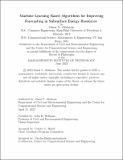Machine Learning Based Algorithms for Improving Forecasting in Subsurface Energy Resources
Author(s)
Alolayan, Omar S.
DownloadThesis PDF (3.969Mb)
Advisor
Williams, John R.
Terms of use
Metadata
Show full item recordAbstract
Energy is an essential human need that is necessary for maintaining and improving quality of life. It also plays a crucial role in sustaining and developing the world economy. Accurate production forecasting models are important for governments, organizations, and companies as they enable them to make informed decisions and develop returns on investments. However, forecasting models for subsurface energy resources still face several challenges, such as mathematically ill-posed problems and lack of reliable data. Machine learning offers new methods to develop better forecasting models due its capacity to learn desired behavior from interacting with an environment of interest, as well as its ability to create optimal non-linear mappings between input and output data.
In this research work, we reformulate the history matching problem from a least-square mathematical optimization problem into a Markov Decision Process to develop a method in which reinforcement learning can be utilized to solve the problem. This method provides a mechanism where an artificial deep neural network agent can interact with the reservoir simulator and find multiple different solutions to the problem. Such formulation allows for solving the problem in parallel by launching multiple concurrent environments enabling the agent to learn simultaneously from all the environments at once, achieving significant speed up.
Additionally, we use deep neural networks to generate more accurate shale gas production forecasts in counties with a limited number of sample wells by utilizing transfer learning. By using transfer learning, we provide a way of transferring the knowledge gained from other deep neural network models trained on adjacent counties into the county of interest. This research project uses data from more than 6000 shale gas wells across 17 counties from Texas Barnett and Pennsylvania Marcellus shale formations to test the capabilities of transfer learning. The results reduce the forecasting error between 11% and 47% compared to the widely used Arps decline curve model.
Date issued
2023-06Department
Massachusetts Institute of Technology. Center for Computational Science and Engineering; Massachusetts Institute of Technology. Department of Civil and Environmental EngineeringPublisher
Massachusetts Institute of Technology